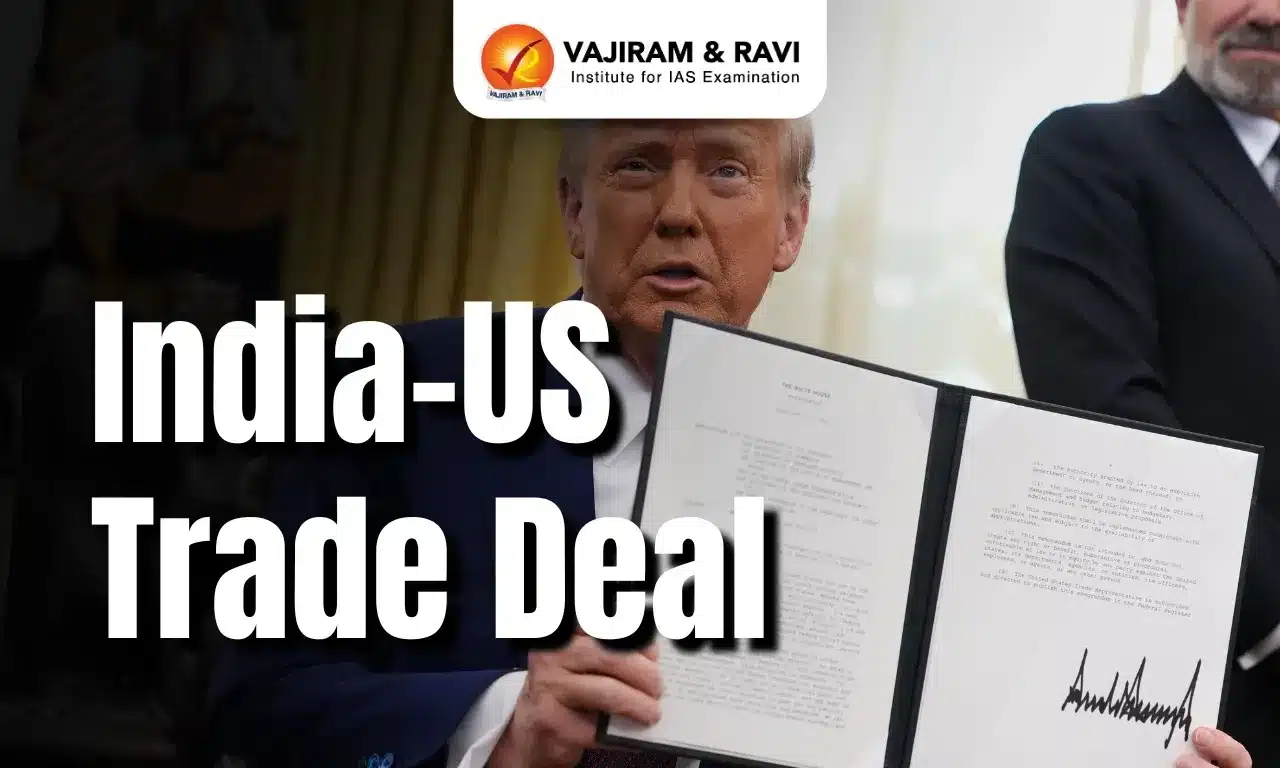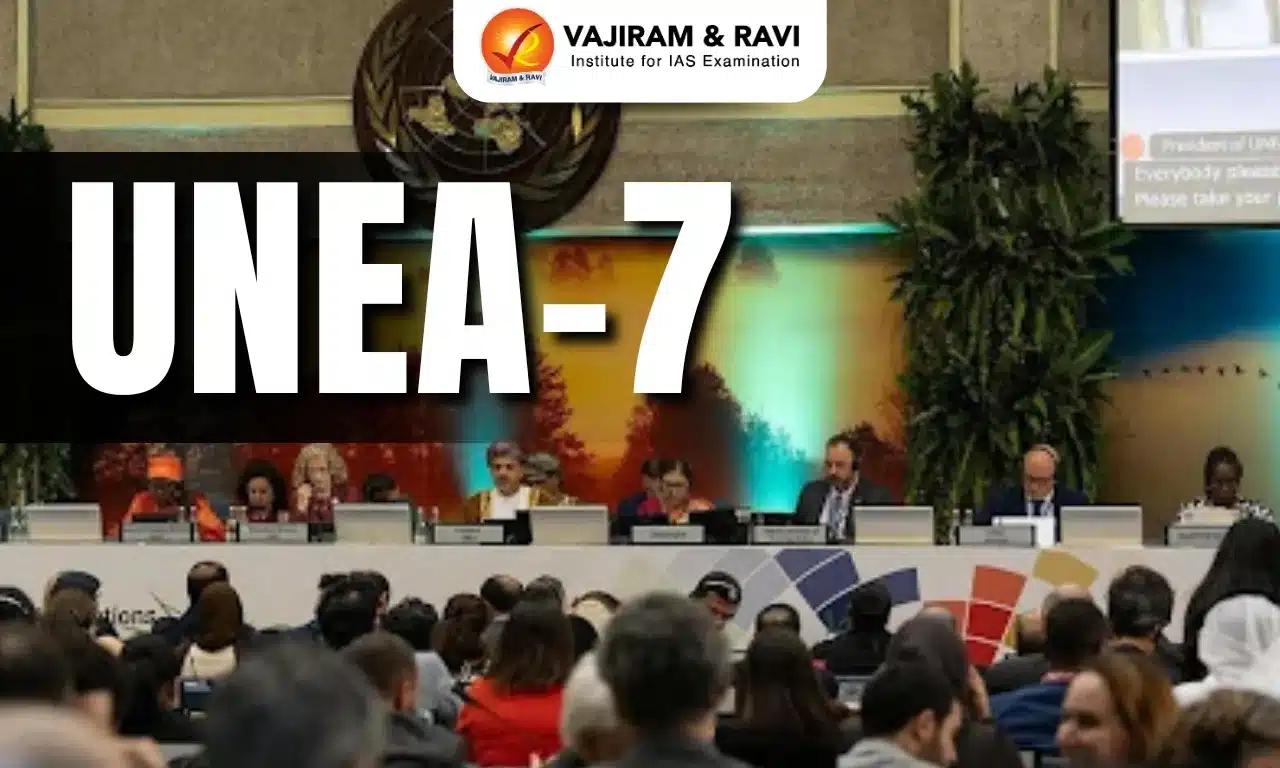What’s in Today’s Article?
- India-US Trade Deal Latest News
- US Criticizes India’s Trade Policy
- India-US Bilateral Trade Overview
- Proposed India-US Trade Agreement
- US Tariff Pressure and India’s Response
- Conclusion: Balancing Trade and Geopolitics
- India-US Trade Deal FAQs
India-US Trade Deal Latest News
- A day before the US reciprocal tariffs take effect on April 2, India has agreed to the Terms of Reference (ToR) for a Bilateral Trade Agreement (BTA) with the US. The ToR sets the negotiation framework and required high-level approval.
- While discussions were still ongoing when US negotiators left after four days of talks, both countries are now set for formal negotiations.
US Criticizes India’s Trade Policy
- The United States Trade Representative (USTR) has raised concerns over India’s trade policies in its ‘Foreign Trade Barriers’ report.
Key Concerns Raised by USTR
- Internet Shutdowns
- The US claims localized shutdowns disrupt commercial activities.
- Dairy Feed Regulations
- India mandates that dairy products must come from animals that have not consumed blood meal or internal organs, a rule the US argues lacks scientific justification.
- Agricultural and GM Food Imports
- India requires GM-free certification for milk, pork, and fish imports, which the US says is not based on scientific risk assessment.
- The report raised concerns over India’s agricultural support programmes, claiming they distort markets.
- It also criticized India’s pulse import restrictions as being opaque and unpredictable.
- India’s Data Localisation Rules
- The USTR report raised concerns over India’s data localisation requirements for payment service providers and banks.
- Since 2018, the Reserve Bank of India (RBI) has mandated that all electronic payment data related to Indian citizens be stored on local servers.
- The US argues that this regulation was introduced without stakeholder consultation and hampers foreign firms’ ability to detect fraud and secure global networks.
- Intellectual Property (IP) Issues
- India remains on the ‘Priority Watch List’ due to weak trade secret protection and slow patent approvals.
- It flagged multiple issues in India’s intellectual property (IP) framework, including:
- Patent Delays: Long waiting periods for patent grants and excessive reporting requirements.
- Patentability Restrictions: The US continues to monitor India’s Section 3(d) of the Patents Act, which limits patentability to prevent evergreening of pharmaceutical patents.
- Weak IP Enforcement: Concerns over inadequate protection of undisclosed test data, lack of an early resolution mechanism for pharmaceutical patent disputes, and delays in trademark opposition proceedings.
- Trade Secret Protection: The absence of specific laws for safeguarding trade secrets.
- Medical Price Controls
- The US criticized India’s price caps on coronary stents and knee implants, arguing they discourage American manufacturers due to inflation and production cost concerns.
India-US Bilateral Trade Overview
- U.S. total goods trade with India were an estimated $129.2 billion in 2024.
- U.S. goods exports to India in 2024 were $41.8 billion, up 3.4 percent ($1.4 billion) from 2023. U.S. goods imports from India totaled $87.4 billion in 2024, up 4.5 percent ($3.7 billion) from 2023.
- The U.S. goods trade deficit with India was $45.7 billion in 2024, a 5.4 percent increase ($2.4 billion) over 2023.
Proposed India-US Trade Agreement
- Both nations plan sector-specific negotiations to finalize a bilateral trade agreement.
- Key objectives:
- Increase market access for goods.
- Reduce tariff and non-tariff barriers.
- Strengthen supply chain integration.
- The US seeks duty reductions on industrial goods, automobiles, wines, petrochemicals, dairy, and agricultural products.
- India may push for concessions on labour-intensive sectors like textiles.
US Tariff Pressure and India’s Response
- Former US President Donald Trump criticized India’s high tariffs, calling them “brutal,” and proposed reciprocal tariffs.
India’s Possible Trade Strategy
- Lobbying for Exemptions: India may negotiate trade exemptions to avoid severe economic impacts.
- ‘Make in India’ Expansion: India could attract companies seeking to exit China and relocate manufacturing.
- Strengthening Trade with Other Regions: Deepening ties with the EU, Southeast Asia, and Africa to reduce dependence on the US.
- Diversifying Trade Relations: Expanding into new markets to minimize risks from US trade policies.
Potential Benefits for India
- Shift in Supply Chains: US tariffs on China could push global manufacturers to expand operations in India.
- Growth in Key Sectors: Electronics, automobiles, and pharmaceuticals may benefit.
- Boost for Indian Automakers: If US tariffs make European and Chinese cars expensive, Indian brands like Tata, Mahindra, and Maruti Suzuki could gain traction.
Conclusion: Balancing Trade and Geopolitics
India’s reaction will depend on the severity of US tariffs and their economic impact. The India-US strategic partnership extends beyond trade, making a balanced approach crucial for both nations.
India-US Trade Deal FAQs
Q1. What is the India-US trade deal about?
Ans. It aims to reduce tariffs, improve market access, and strengthen supply chains between India and the US.
Q2. Why is the US critical of India’s trade policies?
Ans. The US raises concerns over India’s internet shutdowns, IP protection, agricultural restrictions, and data localization rules.
Q3. How does the trade deal affect India?
Ans. India may secure market access, reduce dependency on China, and benefit from US investments in key sectors.
Q4. What are India’s challenges in trade negotiations?
Ans. India faces pressure on tariff reductions, IP rights, and easing restrictions on dairy, agriculture, and medical price controls.
Q5. How will US tariffs impact India’s economy?
Ans. High US tariffs could hurt Indian exports, but India may diversify trade relations and attract manufacturers shifting from China.
Last updated on December, 2025
→ Check out the latest UPSC Syllabus 2026 here.
→ Join Vajiram & Ravi’s Interview Guidance Programme for expert help to crack your final UPSC stage.
→ UPSC Mains Result 2025 is now out.
→ UPSC Notification 2026 is scheduled to be released on January 14, 2026.
→ UPSC Calendar 2026 is released on 15th May, 2025.
→ The UPSC Vacancy 2025 were released 1129, out of which 979 were for UPSC CSE and remaining 150 are for UPSC IFoS.
→ UPSC Prelims 2026 will be conducted on 24th May, 2026 & UPSC Mains 2026 will be conducted on 21st August 2026.
→ The UPSC Selection Process is of 3 stages-Prelims, Mains and Interview.
→ UPSC Result 2024 is released with latest UPSC Marksheet 2024. Check Now!
→ UPSC Prelims Result 2025 is out now for the CSE held on 25 May 2025.
→ UPSC Toppers List 2024 is released now. Shakti Dubey is UPSC AIR 1 2024 Topper.
→ UPSC Prelims Question Paper 2025 and Unofficial Prelims Answer Key 2025 are available now.
→ UPSC Mains Question Paper 2025 is out for Essay, GS 1, 2, 3 & GS 4.
→ UPSC Mains Indian Language Question Paper 2025 is now out.
→ UPSC Mains Optional Question Paper 2025 is now out.
→ Also check Best IAS Coaching in Delhi

















